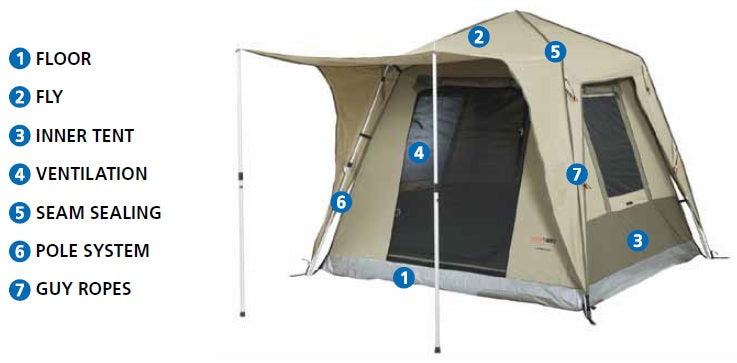
7 Key Tent Features to Consider In Your Next Purchase
|
|
Time to read 7 min
|
|
Time to read 7 min
Selecting the right tent for your outdoor adventures can be overwhelming with the myriad of options available. Here, we break down the seven essential features to consider, ensuring you make an informed choice for your next camping trip.

The flooring in your tent is crucial as it endures constant contact with rough ground, water pooling underneath, and people walking on it. A durable floor enhances the longevity and performance of your tent.
Types of Flooring Materials:
Bucket Flooring: This design raises the floor edges up the sides, providing extra protection against water and wear.
Floor construction can consist of PE (Polyethylene – Tarp material) and PVC (Polyvinyl Chloride). The most common of the materials is a PE floor which can vary in durability depending on the weave of the material. A 14×14 weave is more durable then a 10×10 as the weave is tighter. The Polyester flooring can vary in durability depending on the level of PU (polyurethane) coating applied (3000mm PU, 5000mm PU etc) and the PVC is the most heavy duty and resistant against theelements but it is physically heavier.
The fly of the tent gets a lot of attention as you automatically relate the fly to protecting you from the elements such as wind and rain. The waterproofing level of the tent will generally be a rating along the lines of 2000mm or 3000mm if it is a polyester/nylon material. Canvas construction, however, will just be considered waterproof after soaking the material before use so the canvas material and stitching swell and create a waterproof seal. You may have to reapply waterproofing to the canvas years after the original purchase.
The waterproof level refers to a water column height in millimeters. For example, 3000mm would relate to a water column height of 3 meters (9.8 feet) of water. The fabric is placed at the bottom of the water column and then water is added to a certain height. The fabric must be able to withstand any water from coming through the fabric for more than one minute before the waterproof rating can be allocated.
A PU coating can be applied to the fly and is one of the strongest and most abrasion-resistant kinds of coating. PU optimizes the waterproof level and strength while still being lightweight.
With a canvas tent, it is strongly recommended that it is “weathered” before use. This will allow the canvas to shrink and tighten, and the stitching to swell, becoming waterproof.
The Process:
With the above process, it is recommended to do this a few times to really get the best performance out of the canvas.
Constructed mainly from polyester, the inner tent needs to be lightweight and breathable. Using No-see-um mesh for walls increases ventilation while keeping weight down.
The ventilation can be increased by having more No-see-um mesh as walls rather then polyester.
The ventilation systems objective is to create as much airflow to run through the tent as possible. This is achieved by having vents at the base of the tent just above the bucket flooring and in the roof of the tent. They allow the air to flow freely in and out of the tent. The windows and doors can be constructed of “No-see-um-mesh” and the inner tent can also be constructed of mesh material rather then polyester to allow for even more ventilation.
Having a gap between the Fly and Inner Tent will also allow for more ventilation.
Seam sealing prevents leaks through stitching holes. Techniques include:
You will find several different pole systems within the tent range. They could be constructed from the following:
Aluminium: The obvious benefit to aluminium poles or aluminium pole system is that they are lightweight. The downfall to aluminium is that it is more expensive. These poles will be generally in lightweight hiking tents or Rapid pitch touring tents.
Steel: Steel poles or steel pole systems are going to be more heavy duty compared to the other poles on the market and they can be galvanised giving them more resistance to the elements. These poles will be generally in large Canvas cabin tents.
Fibreglass: Fibreglass poles are flexible, lightweight and come in sections so they are easily replaced if a section was to break. Fibreglass pole systems have become more user friendly over time as the can be coloured poles to match coloured tabs and pole attachment points to make working out what pole goes where a lot easier. The extra features added to fibreglass poles are Durawrap which is an additional fibreglass weave that intersects to create more strength and then the plastic coated fibreglass poles which go that extra step in strength.
Guy ropes are a crucial component for ensuring that the fly of a tent can perform its job effectively, keeping you dry and secure. Here’s a more detailed look at their importance and technical aspects:
Tension and Stability:
Water Runoff:
Material and Durability:
Adjustability:
Attachment Points:
Camping Australia has a wide selection of camping and outdoor equipment including a wide array of quality tents for purchase online and delivered Australia wide.